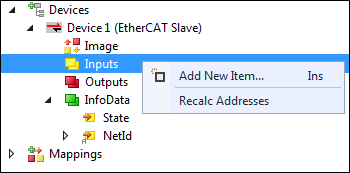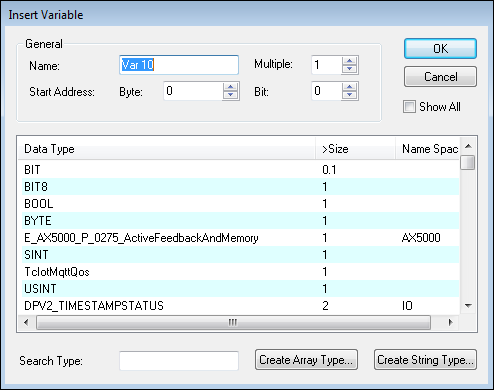Creating process data
 | Incorrectly set address offsets for the EtherCAT slave interface lead to a crash. For devices with Arm® processors, pay attention to the alignment and set the correct address offset in TwinCAT.
|
Up to 512 bytes of input and output data or 256 variables can be exchanged via the EtherCAT slave interface (X101, X102). The 512 bytes of input and output data cannot be created individually, since 512 variables are required for this.
To avoid an excessive number of links, it is advisable to store data in a data structure. Note that the data structures used are processed differently on an x86 system and an Arm® Cortex®-A9 processor. An Arm® Cortex®-A9 processor, for example, always assigns WORD variables (2 bytes) to an even address and DWORD variables (4 bytes) to an address that can be divided by 4.
Data structure sample:
byTest :BYTE;
udTest:UDINT;
Arm® address | Arm® variable | x86 address | Arm® variable |
|---|---|---|---|
Byte Offset 0 | Byte | Byte Offset 0 | BYTE |
Byte Offset 4 | UDINT | Byte Offset 1 | UDINT |
Sum: 8 bytes | Sum: 5 bytes | ||
You can determine the length of a data structure on both systems using the SIZEOF command. If the length of the data structure is different, this indicates that the data structure is unsuitable.
You can solve the problem by smarter arrangement of the variables or by using filler or dummy variables.
Arm® address | Arm® variable | x86 address | Arm® variable |
|---|---|---|---|
Byte Offset 0 | Byte | Byte Offset 0 | BYTE |
Byte Offset 1 | BYTE (Dummy1) | ||
Byte Offset 2 | BYTE (Dummy2) | ||
Byte Offset 3 | BYTE (Dummy3) | ||
Byte Offset 4 | UDINT | Byte Offset 4 | UDINT |
Sum: 8 bytes | Sum: 8 bytes | ||
Create process data as follows:
- 1. Under Devices in the tree view on the left, right-click on Inputs to create input variables.

- 2. In the context menu, click Add New Item. The Insert Variable menu appears.

- 3. Select the required variables and confirm with OK. Click the Create Array Type button to create data structures.
- You have successfully created input variables. Repeat the steps to create output variables in the same way.